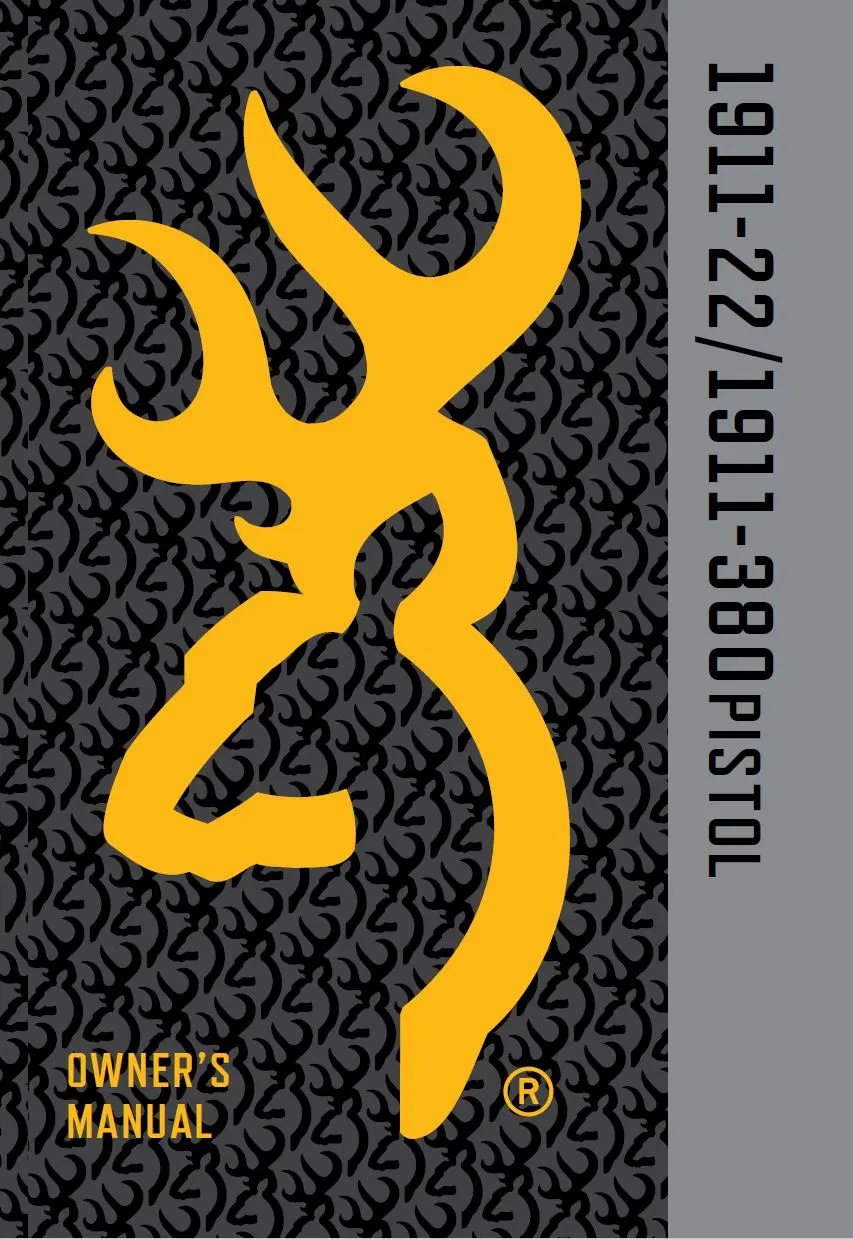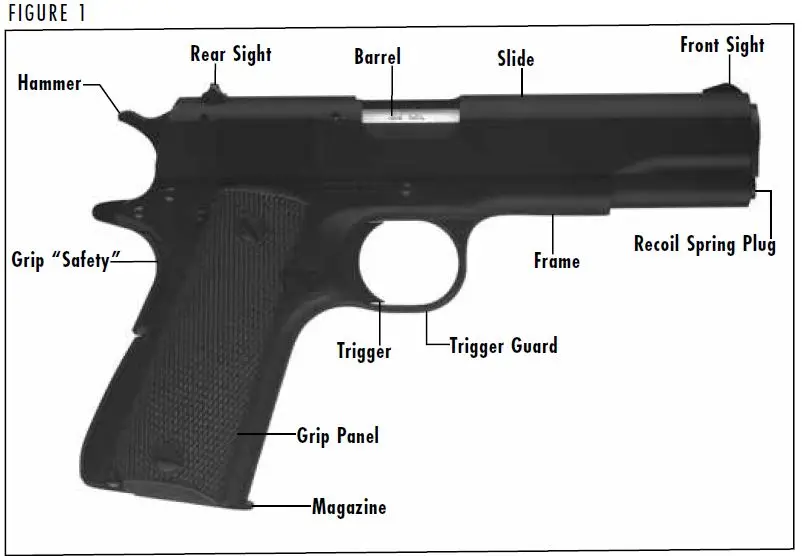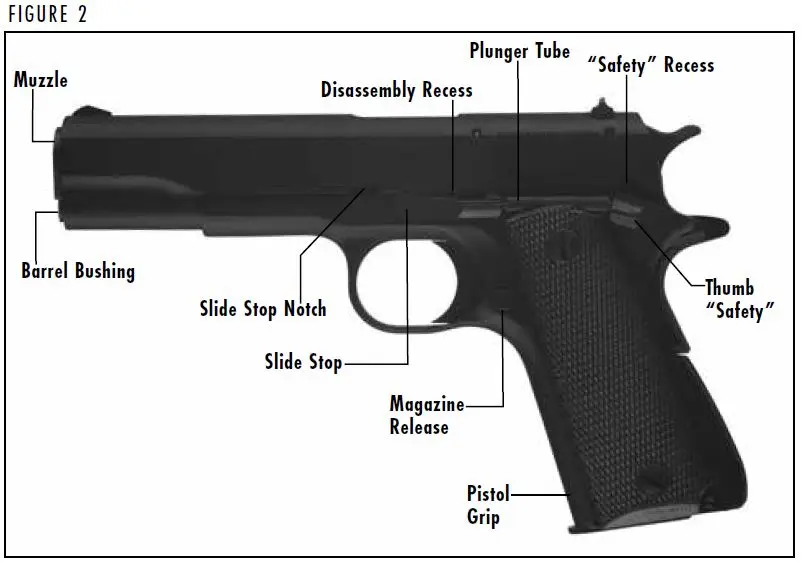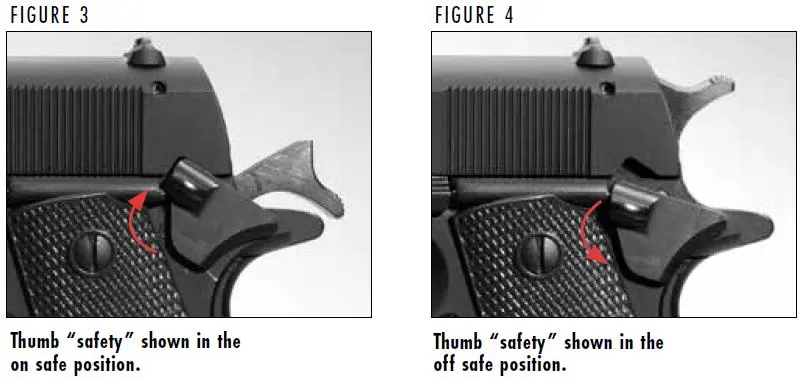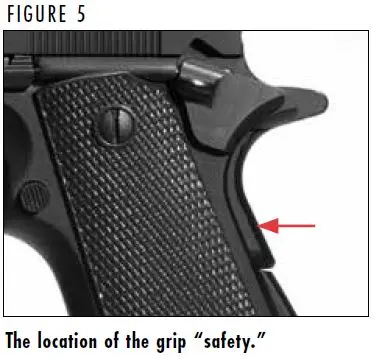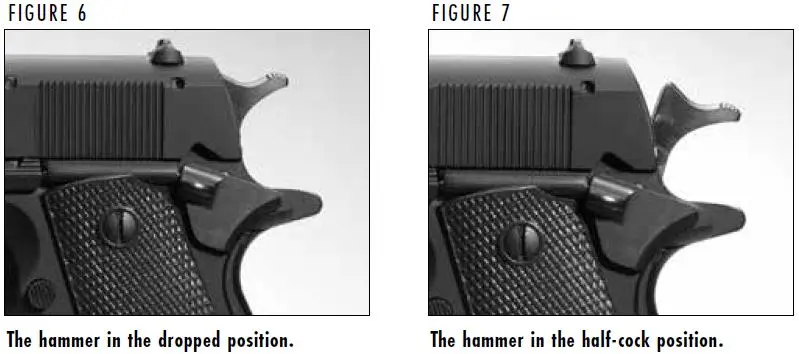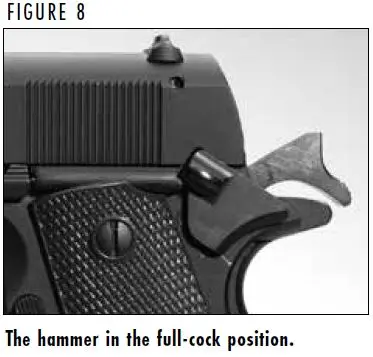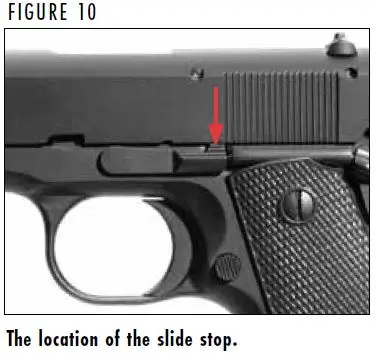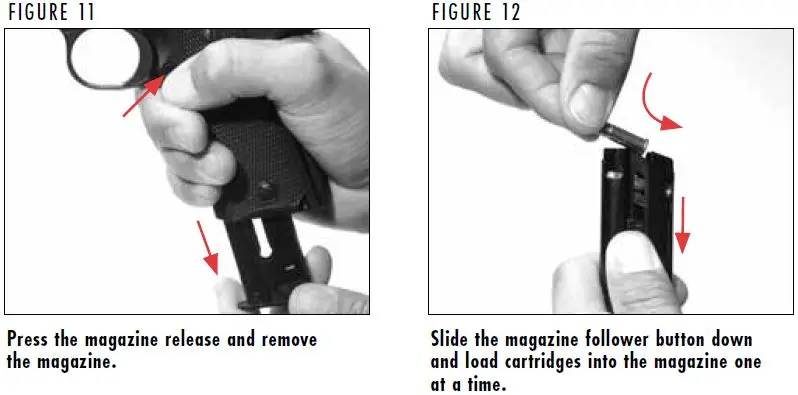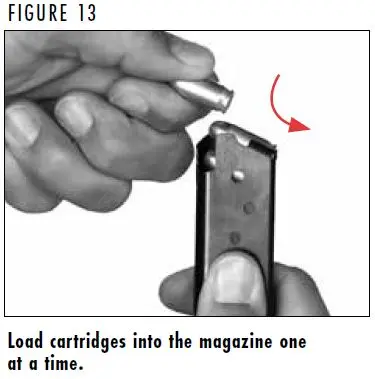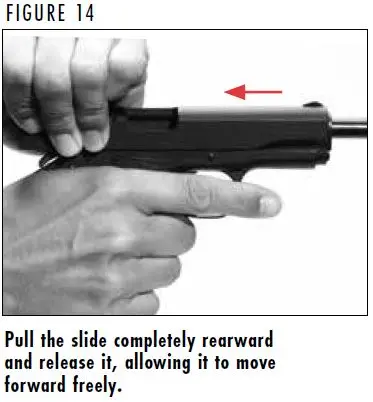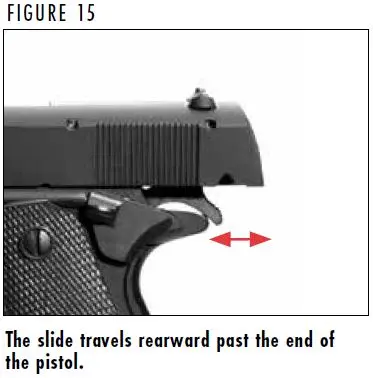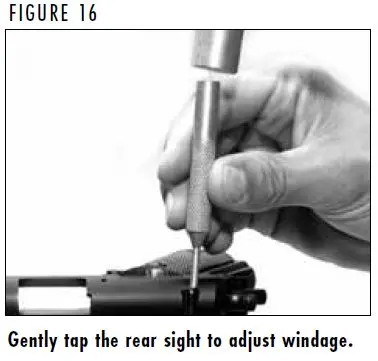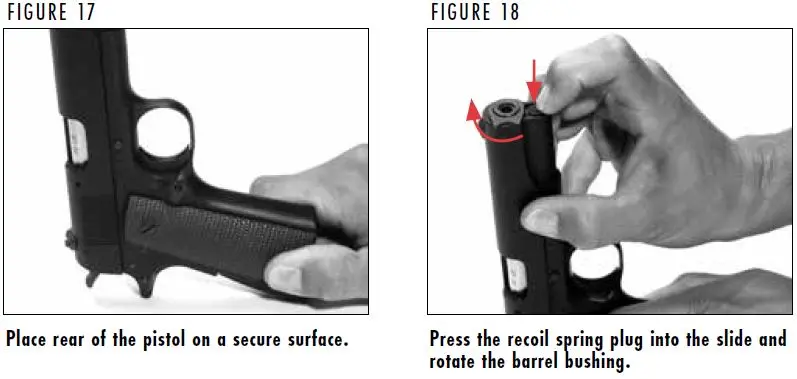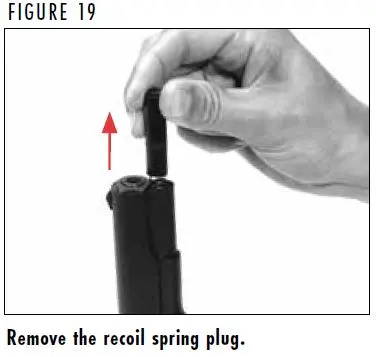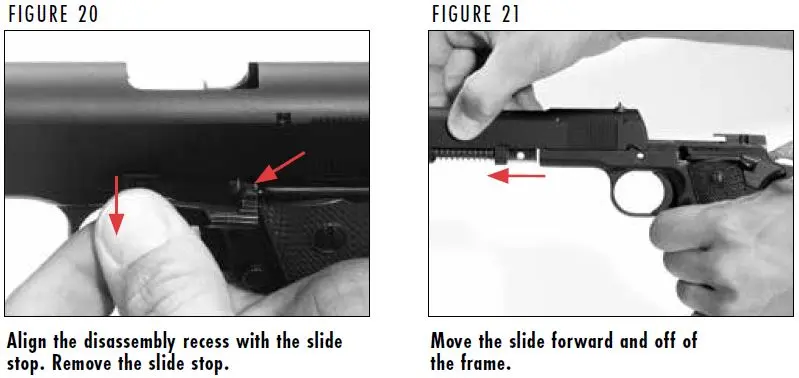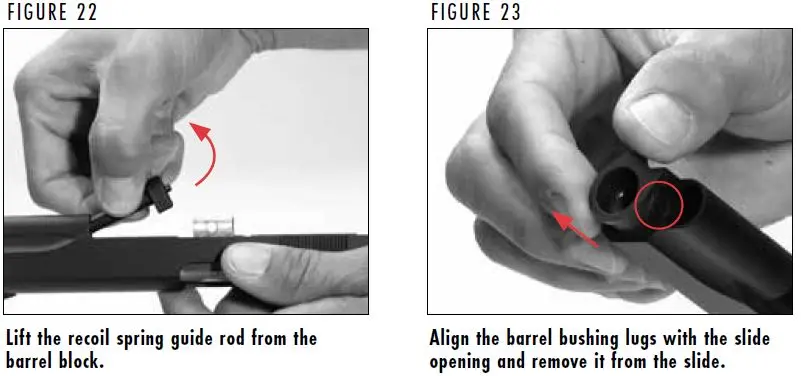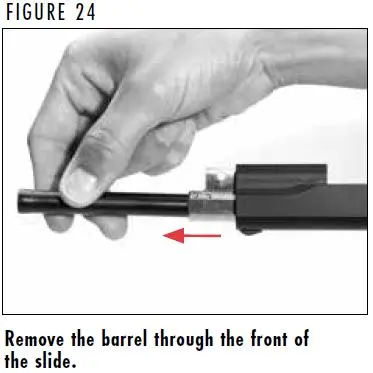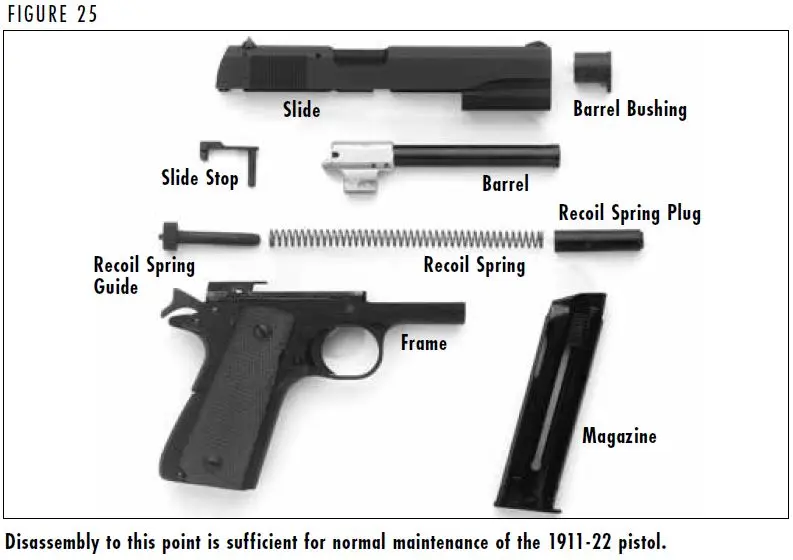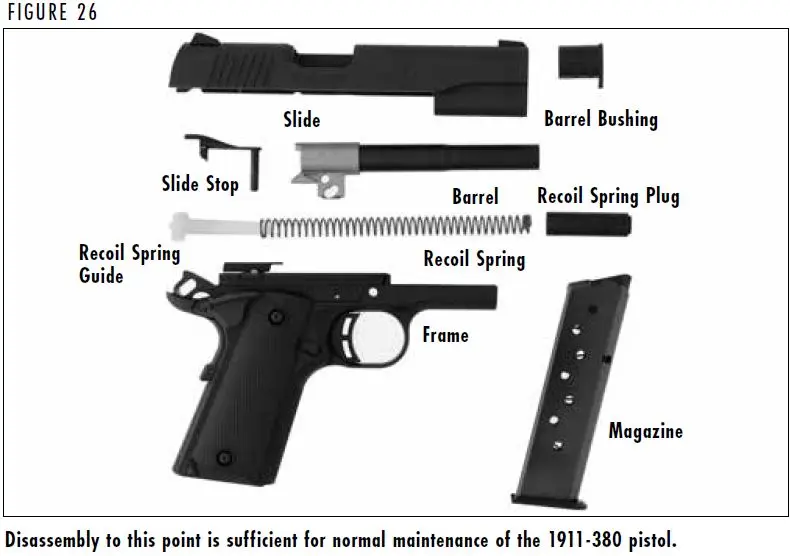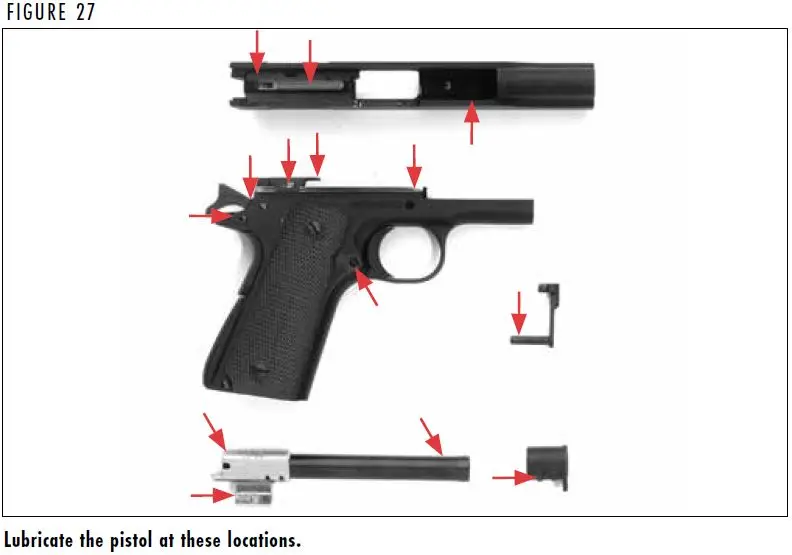1911-22 and 1911-380 Owner's Manual
1911-22 and 1911-380 Owner's Manual
Important operating instructions for: Browning 1911-22 and 1911-380 Autoloading Pistols.
If you have any questions about your new firearm, this owner’s manual or other Browning products, contact:
Browning Customer Service
One Browning Place
Morgan, UT 84050-9326
Phone: (800) 333-3288
browning.com
Please use the space below to record information about your new firearm.
Model __________________________________________________
Serial Number ____________________________________________
Purchased From __________________________________________
Date of Purchase __________________________________________
THANK YOU FOR CHOOSING BROWNING.
We are pleased that you have chosen a Browning 1911-22 or 1911-380 pistol. These firearms trace their heritage to possibly the most famous handgun ever built, John M. Browning’s storied Model 1911. Similar in construction to the Model 1911, the 1911-22 and 1911-380 are smaller in size and lighter in weight to better fit the needs of shooters.
With a reasonable amount of care, your Browning pistol should give you many years of dependable, enjoyable service.
Specifications within this owner’s manual are correct at the time of printing and subject to change without notice.
You Are Responsible for Firearms Safety
STATE WARNING
According to state law, California requires that firearm manufacturers, distributors and retailers include conspicuous, specific warnings with firearms sold in that state.
Firearms must be handled responsibly and securely stored to prevent access by children and other unauthorized users.
California has strict laws pertaining to firearms, and you may be fined or imprisoned if you fail to comply with them. Visit the Web site of the California Attorney General at https://oag.ca.gov/firearms for information on firearm laws applicable to you and how you can comply.
Prevent child access by always keeping guns locked away and unloaded when not in use. If you keep a loaded firearm where a child obtains and improperly uses it, you may be fined or sent to prison.
Las armas de fuego deben de ser manipuladas responsablemente y almacenadas en sitios seguros para prevenir el acceso a ellas por parte de niños y personas sin autorización.
California cuenta con leyes estrictas sobre las armas de fuego, y puede ser multado y encarcelado si no las obedece. Visite la página web de California Attorney General, https://oag.ca.gov/firearms para más información sobre cómo cumplir con las leyes de armas de fuego.
Prevenga el acceso de los niños a las armas de fuego manteniéndolas siempre en un lugar seguro, bajo llave y descargadas cuando no estén en uso. Si usted deja un arma cargada al alcance de un niño, y éste la utiliza indebidamente,usted podría ser multado e incluso enviado a la cárcel.
WARNING: YOU ARE RESPONSIBLE FOR FIREARMS SAFETY
FAILURE TO HEED ANY OF THE FOLLOWING WARNINGS COULD RESULT IN SERIOUS INJURY OR DEATH.
As a gun owner, you accept a set of demanding responsibilities. How seriously you take these responsibilities can be the difference between life and death.
There is no excuse for careless or abusive handling of any firearm. At all times handle this firearm, and all other firearms, with intense respect for their power and potential danger.
Please read and understand all of the cautions, warnings, notices, proper handling procedures and instructions outlined in this owner’s manual before using your new firearm.
1 - ALWAYS KEEP THE MUZZLE OF YOUR FIREARM POINTED IN A SAFE DIRECTION EVEN THOUGH YOU ARE CERTAIN IT IS UNLOADED. Never point any firearm at anything you do not intend to shoot. Be extremely alert and aware of all persons and property within the range of your ammunition.
2 - NEVER RELY TOTALLY ON YOUR FIREARM'S MECHANICAL “SAFETY” DEVICE. LIKE ANY MECHANICAL DEVICE, A "SAFETY" CAN SOMETIMES FAIL; IT CAN BE JARRED OR INADVERTENTLY MANIPULATED INTO AN UNSAFE CONDITION. The word, “safety,” describes a firearm’s trigger block mechanism, sear block mechanism, hammer block mechanism, or firing pin block mechanism. Mechanical “safeties” are designed to place your firearm in a safer status, and no guarantee can be made that the firearm will not fire even if the “safety” is in the on safe position. Mechanical “safeties” merely aid safe gun handling and are no excuse for pointing your firearm’s muzzle in an unsafe direction. See “Operation of the Safety” section below for instructions on the operation of this firearm’s “safety.”
Remember, safe gun handling does not stop with your firearm’s mechanical “safety” devices, it starts there. Always treat this firearm with the respect that you would a loaded, ready-to-fire firearm.
Some firearms do not have a mechanical safety. Many target firearms, lever-action firearms, and pistols do not have manual “safety” mechanisms. Therefore it is critical to read and understand the owner’s manual for every firearm which explains the safe operation of the firearm.
While it is a good idea to “test” your firearm’s mechanical “safety” periodically for proper function, never test the “safety” while your firearm is loaded or pointed in an unsafe direction.
3 - WHENEVER YOU HANDLE ANY FIREARM, OR HAND IT TO SOMEONE, ALWAYS OPEN THE ACTION IMMEDIATELY AND VISUALLY CHECK THE FIREARM'S CHAMBER TO MAKE CERTAIN THAT THE FIREARM IS COMPLETELY UNLOADED. Make certain the firearm does not inadvertently contain any ammunition. Remember, merely removing the magazine does not mean the chamber is unloaded. Always keep the chamber empty and the “safety” in the on safe position unless shooting is imminent.
4 - ALWAYS WEAR EAR AND EYE PROTECTION WHEN SHOOTING. Unprotected, repeated exposure to gunfire can cause hearing damage. Wear hearing protection (shooting ear plugs or muffs) to guard against such damage.
Wear shooting glasses to protect your eyes from flying particles. Allow proper distance (eye relief) between a scope and your
eye when firing a scoped pistol, rifle or shotgun. Do not use unorthodox shooting methods that could cause the rearward travel of the slide or bolt of a firearm to contact your eyes, face or hands. Always keep a safe distance between the muzzle of your firearm and any persons nearby, as muzzle blast, debris and ejecting cartridges could inflict serious injury.
Always wear eye protection when disassembling and cleaning any firearm to prevent the possibility of springs, spring-tensioned parts, solvents or other agents from contacting your eyes.
5 - KEEP ALL FIREARMS UNLOADED DURING TRANSPORT, EVEN WHEN STORED IN A HOLSTER, GUN CASE, SCABBARD, OR OTHER CONTAINER.
6 - DROPPING OR JARRING A LOADED FIREARM CAN CAUSE ACCIDENTAL DISCHARGE. This can occur even with the “safety” in the on safe position. Be extremely careful while hunting or during any shooting activity to avoid dropping any firearm.
7 - HUNTING FROM ELEVATED SURFACES SUCH AS TREESTANDS IS DANGEROUS. Doing so may increase the risk of mishandling a firearm. The following rules should always be observed by you and those you hunt with: Always make certain that the stand being used is safe and stable. Always make certain that your firearm is unloaded when it is being taken up and down from the stand. Always make certain that your firearm is not dropped from the stand, or dropped while it is being taken up or down from the stand. Remember, a loaded firearm may discharge when dropped, even with the “safety” in the on safe position.
8 - STORE YOUR FIREARM AND AMMUNITION SEPARATELY, WELL BEYOND THE REACH OF CHILDREN. Take prudent safeguards to ensure your firearm does not become available to untrained, inexperienced or unwelcome hands. Store all firearms in secure, locked cases or a gun safe. Keep your firearm unloaded when not in use.
9 - BEWARE BARREL OBSTRUCTIONS. Mud, snow and an infinite variety of other objects may inadvertently lodge in a barrel bore. It only takes a small obstruction to cause dangerously increased pressures that can damage your firearm and cause serious injury to yourself and others..
BEFORE CHECKING FOR A BARREL OBSTRUCTION, BE CERTAIN YOUR FIREARM IS COMPLETELY UNLOADED, THERE IS NOT A LIVE CARTRIDGE IN THE CHAMBER AND THE “SAFETY” IS IN THE ON SAFE POSITION.
After assuring yourself that the firearm is completely unloaded, open the breech or action and look through the barrel to be sure it is clear of obstructions. If an obstruction is seen, no matter how small it may be, clean the bore with a cleaning rod and patch as described in the Cleaning and Maintenance section of this owner’s manual.
10 - BE ALERT TO THE SIGNS OF AMMUNITION MALFUNCTION. IF YOU DETECT AN OFF SOUND OR LIGHT RECOIL WHEN A CARTRIDGE IS FIRED, DO NOT LOAD ANOTHER CARTRIDGE INTO THE CHAMBER.
If your firearm fails to fire, keep the muzzle pointed in a safe direction for a minimum of 30 seconds. Rotate the ejection area of the firearm away from you, carefully open the action and remove the cartridge from the chamber. If the primer is indented, the defective cartridge should be disposed of in a way that cannot cause harm. If the primer is not indented, your firearm should be examined by a qualified gunsmith and the cause of the malfunction corrected before further use. Glance down the barrel to make sure that no obstructions remain in the barrel. Completely clear the barrel before loading and firing again. Failure to follow these instructions can cause extensive damage to your firearm and possible serious injury to yourself and others.
11 - NEVER INSERT A CARTRIDGE OF THE INCORRECT CALIBER INTO ANY FIREARM. The caliber of your firearm is marked on the barrel. Store all cartridges of different calibers in completely separate and well-marked containers. Never store cartridges of mixed calibers in a common container or in your pockets. See the ammunition section below for more information on the correct ammunition for your firearm.
12 - EXAMINE EVERY CARTRIDGE YOU PUT IN YOUR FIREARM.
We cannot assume any responsibility for the use of unsafe or improper firearm and ammunition combinations or damage or injury caused by damaged ammunition. It is your responsibility to read and heed all warnings in this owner’s manual and on ammunition boxes. See the ammunition section below for more information on the correct ammunition for your firearm.
13 - USE ONLY SAAMI APPROVED AMMUNITION.
The barrel and action of this firearm have been made with substantial safety margins beyond the pressures developed by established American commercial loads. Nevertheless, we can assume no liability for incidents that occur through the use of cartridges of nonstandard dimensions or which develop pressures in excess of commercially available ammunition which have been loaded in accordance with standards established by the Sporting Arms and Ammunition Manufacturers’ Institute (SAAMI).
14 - DISCHARGING FIREARMS IN POORLY VENTILATED AREAS, CLEANING FIREARMS OR HANDLING AMMUNITION MAY RESULT IN EXPOSURE TO LEAD AND OTHER SUBSTANCES KNOWN TO CAUSE BIRTH DEFECTS, REPRODUCTIVE HARM AND OTHER SERIOUS PHYSICAL INJURY. HAVE ADEQUATE VENTILATION AT ALL TIMES. WASH HANDS THOROUGHLY AFTER EXPOSURE.
15 - DO NOT SNAP THE FIRING PIN ON AN EMPTY CHAMBER, THE CHAMBER MAY NOT BE EMPTY!
Treat every firearm with the respect due a loaded firearm, even though you are certain the firearm is unloaded.
16 - KEEP YOUR FINGERS AWAY FROM THE TRIGGER WHILE LOADING AND UNLOADING UNTIL SHOOTING IS IMMINENT.
17 - BE SURE OF YOUR TARGET AND BACKSTOP, PARTICULARLY DURING LOW LIGHT PERIODS. Know the range of your ammunition. Never shoot at water or hard objects.
18 - ALWAYS UNLOAD YOUR FIREARM'S CHAMBER BEFORE CROSSING A FENCE, CLIMBING A TREE, JUMPING A DITCH OR NEGOTIATING OTHER OBSTACLES. Never place your firearm on or against a fence, tree, car, or other similar object.
19 - BE DEFENSIVE AND ON GUARD AGAINST UNSAFE GUN HANDLING AROUND YOU AND OTHERS. Don’t be timid when it comes to firearm safety. If you observe other shooters violating any of these safety precautions, politely suggest safer handling practices.
20 - BE CERTAIN YOUR FIREARM IS UNLOADED BEFORE CLEANING. Because so many firearm accidents occur when a firearm is being cleaned, special and extreme care should be taken to be sure your firearm is unloaded before disassembly, cleaning, and reassembly. Keep ammunition away from the cleaning location. Never test the mechanical function of any firearm with live ammunition.
21 - TEACH AND SUPERVISE FIREARMS SAFETY TO ALL MEMBERS OF YOUR FAMILY, ESPECIALLY TO CHILDREN AND NON-SHOOTERS. Closely supervise newcomers to the shooting sports. Encourage enrollment in hunting and shooting safety courses.
22 - NEVER DRINK ALCOHOLIC BEVERAGES OR TAKE ANY TYPE OF DRUGS BEFORE OR DURING SHOOTING. Your vision, motor skills, and judgment could be dangerously impaired, making your gun handling unsafe to you and to others.
23 - READ AND HEED ALL WARNINGS IN THIS OWNER'S MANUAL, ON AMMUNITION BOXES, AND WITH ALL ACCESSORIES THAT YOU INSTALL ON YOUR FIREARM. It is your responsibility to secure the most up-to-date information on the safe handling procedures of your Browning firearm. We assume no liability for incidents that occur when unsafe or improper firearm accessories or ammunition combinations are used.
24 - PRACTICE PERIODIC MAINTENANCE, AVOID UNAUTHORIZED SERVICING. Your firearm is a mechanical device that will not last forever, and as such, is subject to wear and requires periodic inspection, adjustment and service. Browning firearms should be serviced by a Browning Recommended Service Center or by our Service Facility in Arnold, Missouri. We cannot assume any responsibility for injuries suffered or caused by unauthorized servicing, alterations or modifications of Browning firearms.
25 - DO NOT, UNDER ANY CIRCUMSTANCES, ALTER THE TRIGGER, SAFETY OR OTHER PARTS OF THE FIRING MECHANISM OF THIS OR ANY OTHER FIREARM EXCEPT AS OTHERWISE DESCRIBED IN THIS MANUAL.
WE RESERVE THE RIGHT TO REFUSE SERVICE ON FIREARMS THAT HAVE BEEN ALTERED, ADDED TO OR SUBSTANTIALLY CHANGED. Removal of metal from the barrel, or modifications of the firing mechanism and/or operating parts, may lead to a refusal of service on such firearms. You will be charged for parts and labor to return the firearm to original specifications prior to servicing your firearm.
With respect to AFTERMARKET PARTS OR COMPONENTS (including, for example, aftermarket trigger systems, barrels, muzzle brakes, suppressors, magazines, etc.), USE AT YOUR OWN RISK. Browning firearms are designed and engineered to meet stringent safety standards. Browning is not responsible for personal injuries or property damage caused by alterations to a firearm. This includes the incorporation of aftermarket parts or components that may or may not satisfy Sporting Arms and Ammunition Manufacturers’ Institute (SAAMI) standards (for example, an aftermarket trigger system may not satisfy SAAMI minimum trigger pull standards, etc.) or may create other dangerous conditions. These conditions may or may not be apparent to the user (for example, installing an aftermarket barrel may have the effect of altering critical firearm dimensions, including headspace, and may create an unsafe firing condition, etc.). Aftermarket parts or components that do not satisfy SAAMI standards, or that could create other dangerous conditions, should not be used.
FAILURE TO FOLLOW THIS WARNING COULD RESULT IN SERIOUS INJURY OR DEATH, AS WELL AS CAUSE DAMAGE TO YOUR FIREARM.
BE CAREFUL!
BE CAREFUL!
GENERAL DESCRIPTION AND OPERATION
The Browning 1911-22 is a recoil-operated, straight-blowback, single-action autoloading pistol. The Browning 1911-380 is a recoil-operated, tilting barrel, locked-breech, single-action autoloading pistol. With the chamber and magazine loaded, the “safety” in the off safe or fire position, the grip “safety” depressed and the hammer cocked, the pistols will fire a single cartridge with each successive pull of the trigger until the magazine and chamber are empty. The slide is designed to stay open after the last cartridge has been fired.
NOTICE: DO NOT DRY FIRE THE 1911-22 PISTOL. DRY FIRING MAY DAMAGE THE FIREARM COMPONENTS, POSSIBLY RENDERING THE FIREARM INOPERABLE.
NOMENCLATURE
In conventional firearm terminology, the position and movement of parts are described as they occur with the firearm horizontal and in the normal firing position; i.e. the muzzle is forward or front; the pistol grip is rearward or rear; the trigger is downward or underneath; the sights are upward or on top. For general nomenclature refer to Figure 1 and Figure 2 above.
SERIAL NUMBER
The serial number of your firearm is found stamped on the right side of the frame, above the trigger guard.
WARNING: ALWAYS KEEP THE THUMB “SAFETY” IN THE ON SAFE POSITION WHEN THE HAMMER IS IN THE FULL-COCK POSITION UNLESS SHOOTING IS IMMINENT. ALWAYS KEEP THE MUZZLE POINTED IN A SAFE DIRECTION. FAILURE TO FOLLOW THESE WARNINGS COULD RESULT IN SERIOUS INJURY OR DEATH.
“SAFETY” MECHANISM
Browning 1911-22 A1 pistols feature a manual thumb “safety” located on the left side of the firearm and a grip “safety” located on the upper rear portion of the pistol grip.
Black Label models of the Browning 1911-22 and 1911-380 feature an ambidextrous manual thumb “safety” that can be operated from either side of the firearm and a grip “safety” located on the upper rear portion of the pistol grip.
For the pistol to fire, the thumb “safety” must be in the off safe position and the grip “safety” must be depressed.
THUMB “SAFETY” — ON SAFE POSITION
To place the “safety” in the on safe position, push the “safety” lever upward into the recess located in the rearward portion of the slide
(Figure 3). The “safety” lever cannot be placed in the on safe position if the hammer is in the dropped or half-cock positions.
THUMB “SAFETY” — OFF SAFE POSITION
To place the “safety” in the off safe or ready-to-fire position, move the thumb “safety” downward from the recess in the slide (Figure 4). With the grip “safety” depressed, a cartridge in the chamber and the magazine inserted, the pistol is now ready to fire by pulling the trigger.
GRIP "SAFETY"
The grip “safety” is located on the rear of the grip, just below the hammer, and blocks the trigger from moving rearward (Figure 5). To disengage the grip “safety,” hold the pistol grip securely with your hand in a normal shooting position.
MAGAZINE “SAFETY”
This handgun is equipped with a magazine “safety” that is designed to prevent the trigger from being pulled unless a magazine is inserted into the magazine well. Unless firing is imminent, only use an unloaded magazine to disengage the magazine “safety.”
WARNING: THE MAGAZINE “SAFETY” IS A MECHANICAL “SAFETY” DEVICE. LIKE ANY MECHANICAL DEVICE, IT MAY FAIL. ALWAYS KEEP THE “SAFETY” IN THE ON SAFE POSITION AND THE MUZZLE POINTED IN A SAFE DIRECTION. FAILURE TO FOLLOW THESE WARNINGS COULD RESULT IN SERIOUS INJURY OR DEATH.
OPERATION OF THE HAMMER
OPERATION OF THE HAMMER
The Browning 1911-22 and 1911-380 are single-action pistols featuring an exposed hammer with dropped, half-cock and full-cock positions. The hammer spur is serrated to help ensure positive control while manually cocking and lowering the hammer. In order for the trigger to operate the hammer, the magazine must be inserted in the pistol.
DROPPED POSITION
The dropped position on an empty chamber is the recommended position of the hammer at all times except when shooting is imminent (Figure 6). In the dropped position, the hammer is fully forward and resting against the firing pin, however, the firing pin is not in contact with the cartridge.
WARNING: DO NOT CARRY OR STORE THE PISTOL WITH A CARTRIDGE IN THE CHAMBER. ALWAYS KEEP THE HAMMER IN THE DROPPED POSITION UNLESS SHOOTING IS IMMINENT. ALWAYS KEEP THE MUZZLE POINTED IN A SAFE DIRECTION. FAILURE TO FOLLOW THESE WARNINGS COULD RESULT IN SERIOUS INJURY OR DEATH.
HALF -COCK POSITION
The half-cock hammer position is between the dropped position and full-cock position (Figure 7). The half-cock position is designed to prevent the hammer from striking the firing pin should your thumb slip off of the hammer while cocking the hammer or lowering the hammer to the dropped position.
WARNING: DO NOT CARRY OR STORE THE PISTOL WITH THE HAMMER IN THE HALF-COCK POSITION. THE HALF-COCK POSITION IS PROVIDED ONLY AS A MEANS OF CATCHING THE HAMMER SHOULD IT SLIP FROM YOUR THUMB WHILE LOWERING THE HAMMER FROM FULL-COCK TO DROPPED POSITION OR WHEN COCKING THE PISTOL. IF THE HAMMER SHOULD SLIP WHILE THE TRIGGER IS DEPRESSED, THE HALF-COCK NOTCH WILL NOT PREVENT THE HAMMER FROM STRIKING THE FIRING PIN. KEEP YOUR FINGER OFF THE TRIGGER WHEN YOU ARE COCKING THE HAMMER, AND WHEN YOU ARE LOWERING THE HAMMER. FAILURE TO FOLLOW THESE WARNINGS COULD RESULT IN SERIOUS INJURY OR DEATH.
FULL - COCK POSITION
In the full-cock position, the hammer is fully rearward (Figure 8). In the full-cock position, with the “safety” in the off safe position, a magazine inserted and with a cartridge in the chamber, the pistol is ready to fire by pulling the trigger.
WARNING: WHEN LOWERING THE HAMMER ALWAYS KEEP THE MUZZLE POINTED IN A SAFE DIRECTION. BE CERTAIN YOUR FIREARM IS COMPLETELY UNLOADED AND THERE IS NOT A LIVE CARTRIDGE IN THE CHAMBER. FAILURE TO FOLLOW THESE WARNINGS COULD RESULT IN SERIOUS INJURY OR DEATH.
To lower the hammer from the full-cock position to the dropped position, perform the following procedure.
- Ensure the firearm is completely unloaded as explained in Unloading Section. Place the “safety” in the on safe position.
- Insert an unloaded magazine into the pistol.
- Point the muzzle in a safe direction, grip the firearm in a normal shooting manner and move the “safety” into the off safe position.
- Grasp the hammer with your other hand and squeeze the trigger to allow the hammer to move forward slowly, under control (Figure 9). Slowly allow the hammer to travel forward until it is stopped in the half-cock position.
- With the hammer in the half-cock position, again, draw the hammer slightly rearward and gently squeeze the trigger until the hammer moves forward past the half-cock position.
- Ease the hammer down against the firing pin. The hammer is now in the dropped position.
WARNING: WHEN THE HAMMER PASSES THE FULL-COCK POSITION REMOVE YOUR FINGER FROM THE TRIGGER. THIS WILL ALLOW THE HAMMER TO CATCH AT THE HALF-COCK POSITION SHOULD THE HAMMER SLIP FROM YOUR THUMB. FAILURE TO FOLLOW THIS WARNING COULD RESULT IN SERIOUS INJURY OR DEATH.
SLIDE STOP
The slide stop is located on the left side of the pistol (Figure 10). With an empty magazine inserted, the slide can be “locked” rearward simply by grasping the serrations on the rear of the slide and drawing the slide fully rearward until the slide stop automatically moves upward into the recess in the slide. (If an empty magazine is not inserted, the slide stop must be manually pushed upward into its recess in the slide.) After the last shot has been fired from the magazine, the slide will “lock” rearward. This position is an additional safety measure and allows easy inspection of the chamber.
To close the slide, be certain your fingers are away from the ejection port and trigger. With the muzzle of the pistol pointed in a safe direction, simply depress the slide stop located on the left side of the frame. After closing the slide immediately lower the hammer to the dropped position or place the “safety” in the on safe position.
WARNING: MAKE SURE YOUR FINGERS ARE SAFELY AWAY FROM THE CHAMBER WHEN THE SLIDE IS RELEASED TO AVOID PINCHING THEM WHEN THE SLIDE CLOSES. FAILURE TO FOLLOW THIS WARNING COULD RESULT IN INJURY.
INITIAL CLEANING
Various exposed metal parts of your new firearm have been coated at the factory with a rust preventative compound. Before firing your pistol, clean the anti-rust compound from the inside of the barrel, frame and the action-chamber areas. A light gun oil is ideal for removing this compound and for giving your new firearm its first lubrication. However, any quality firearm oil may be used. Clean the barrel using a cleaning rod and patch as explained under “Cleaning and Maintenance Suggestions”. If your pistol is to be stored, it is acceptable to leave the rust preventative compound on the pistol and keep it in its original packaging.
WARNING: DISCHARGING FIREARMS IN POORLY VENTILATED AREAS, CLEANING FIREARMS OR HANDLING AMMUNITION MAY RESULT IN EXPOSURE TO LEAD AND OTHER SUBSTANCES KNOWN TO CAUSE BIRTH DEFECTS, REPRODUCTIVE HARM AND OTHER SERIOUS PHYSICAL INJURY. HAVE ADEQUATE VENTILATION AT ALL TIMES. WASH HANDS THOROUGHLY AFTER EXPOSURE.
BROWNING 1911-22 PISTOLS ARE CHAMBERED FOR 22 LONG RIFLE CARTRIDGES ONLY. DO NOT USE AMMUNITION OTHER THAN WHAT IS INSCRIBED ON THE RIGHT SIDE OF THE BARREL. EXAMINE EVERY CARTRIDGE YOU PUT IN YOUR PISTOL.
BROWNING 1911-380 PISTOLS ARE CHAMBERED FOR 380 ACP CARTRIDGES ONLY. DO NOT USE AMMUNITION OTHER THAN WHAT IS INSCRIBED ON THE RIGHT SIDE OF THE BARREL. EXAMINE EVERY CARTRIDGE YOU PUT IN YOUR PISTOL.
AMMUNITION
The barrel and action of this firearm have been made with safety margins over the pressures established by the Sporting Arms and Ammunition Manufacturers’ Institute (SAAMI) for Service Cartridges. However, we assume no responsibility for incidents which occur through the use of cartridges of nonstandard dimension or those developing pressures in excess of SAAMI established standards.
NOTICE: BROWNING 1911-22 PISTOLS MUST BE USED WITH ONLY 22 LONG RIFLE RIMFIRE AMMUNITION AS DESIGNATED ON THE BARREL. DO NOT SHOOT 22 SHORT OR 22 LONG AMMUNITION OR BLANKS.
ALWAYS READ THE AMMUNITION LABEL AND ANY ENCLOSURES WITH THE AMMUNITION TO ASSURE THAT THE AMMUNITION IS APPROPRIATE OR THAT THERE IS NO RESTRICTION FOR ITS USE WITH YOUR FIREARM.
MAGAZINE
The magazine capacity of the 1911-22 is ten, 22 LR cartridges. The magazine capacity of the 1911-380 is eight, 380 ACP cartridges.
LOADING
LOADING
WARNING: WHEN LOADING YOUR PISTOL ALWAYS KEEP THE MUZZLE POINTED IN A SAFE DIRECTION, THE HAMMER IN THE DROPPED POSITION, AND YOUR FINGERS AWAY FROM THE TRIGGER. FAILURE TO FOLLOW THESE WARNINGS COULD RESULT IN SERIOUS INJURY OR DEATH.
REMOVING AND LOADING THE 1911-22 MAGAZINE
- Press the magazine release on the left side of the frame at the rear of the trigger guard and remove the magazine (Figure 11).
- After removing the magazine, pull the slide rearward and visually inspect the chamber to eliminate any possibility of a cartridge being in the chamber. Close the slide.
- Load the magazine by sliding the magazine follower button, located on the side of the magazine, down with the thumb and forefinger of one hand while inserting the cartridges with the other hand (Figure 12).
WARNING: THE HAMMER IS NOW IN THE FULL-COCK POSITION. IMMEDIATELY PLACE THE “SAFETY” IN THE ON SAFE POSITION. FAILURE TO FOLLOW THIS WARNING COULD RESULT IN SERIOUS INJURY OR DEATH.
REMOVING AND LOADING THE 1911-380 MAGAZINE
- Press the magazine release on the left side of the frame at the rear of the trigger guard and remove the magazine (Figure 11).
- After removing the magazine, pull the slide rearward and visually inspect the chamber to eliminate any possibility of a cartridge being in the chamber. Close the slide. Place "Safety" in the On safe position
- Insert the cartridges into the magazine by pushing downward on the front of the follower with the base of the cartridge and then pushing the cartridge rearward under the feed lips on the magazine with your thumb (Figure 13).
WARNING: THE HAMMER IS NOW IN THE FULL-COCK POSITION. IMMEDIATELY PLACE THE “SAFETY” IN THE ON SAFE POSITION. FAILURE TO FOLLOW THIS WARNING COULD RESULT IN SERIOUS INJURY OR DEATH.
WARNING: DO NOT INSERT A MAGAZINE INTO THE PISTOL IF THE SLIDE IS OPEN. IF THE SLIDE IS OPEN AND A LOADED MAGAZINE IS INSERTED INTO THE PISTOL, A CARTRIDGE COULD INADVERTENTLY BE LOADED INTO THE CHAMBER. FAILURE TO FOLLOW THIS WARNING COULD RESULT IN SERIOUS INJURY OR DEATH.
LOADING THE CHAMBER WITH THE SLIDE CLOSED
- Insert the loaded magazine into the pistol. Be certain to insert the magazine completely until it is retained by the magazine latch.
- If the “safety” is in the on-safe position, move it down into the off-safe position.
- With your fingers away from the trigger, pull the slide completely to the rear and release it. The slide will move forward under spring pressure and feed the first cartridge from the magazine into the chamber (Figure 14). Place "Safety" in the on-safe position.
- If shooting is not imminent, move the “safety” to the off safe position, point the muzzle in a safe direction and immediately lower the hammer to the dropped position as explained previously. If you are finished shooting, the loaded cartridge should be removed from the chamber as explained under “Unloading” section.
WARNING: THE PISTOL IS NOW READY TO FIRE. UNLESS SHOOTING IS IMMINENT, IMMEDIATELY PLACE THE “SAFETY” IN THE ON SAFE POSITION. FAILURE TO FOLLOW THESE WARNINGS COULD RESULT IN SERIOUS INJURY OR DEATH.
WARNING: UNDER MOST CONDITIONS AFTER SHOOTING, YOU SHOULD IMMEDIATELY REMOVE THE EMPTY MAGAZINE, CLOSE THE SLIDE AND PLACE THE THUMB “SAFETY” IN THE ON SAFE POSITION BEFORE INSERTING A LOADED MAGAZINE INTO THE PISTOL. UNDER SPECIAL COMPETITIVE SHOOTING CONDITIONS, YOU MAY LEAVE THE SLIDE OPEN AFTER THE EMPTY MAGAZINE IS REMOVED. FAILURE TO FOLLOW THESE WARNINGS COULD RESULT IN SERIOUS INJURY OR DEATH.
LOADING THE CHAMBER WITH THE SLIDE LOCKED REARWARD
The slide locks to the rear after the last cartridge from the magazine is fired. If you are shooting in competitive matches, and shooting after firing an entire magazine is imminent, it is possible to reload the pistol with the slide locked rearward, chambering a cartridge when the slide is closed.
- With the slide locked rearward, eject the empty magazine from the pistol.
- Insert a loaded magazine into the pistol.
- With the muzzle pointed in a safe direction, release the slide forward by pushing downward on the slide stop with your thumb. The slide will close under spring pressure and feed a cartridge from the magazine into the chamber. Move the "Safety" to the on safe position.
- If shooting is no longer imminent, point the muzzle in a safe direction and immediately lower the hammer to the dropped position as explained previously. If you are finished shooting, the loaded cartridge should be removed from the chamber as explained under “Unloading” section.
WARNING: THE PISTOL IS NOW READY TO FIRE. UNLESS SHOOTING IS IMMINENT, IMMEDIATELY PLACE THE “SAFETY” IN THE ON SAFE POSITION. FAILURE TO FOLLOW THESE WARNINGS COULD RESULT IN SERIOUS INJURY OR DEATH.
WARNING: NEVER CHAMBER A CARTRIDGE OR MOVE THE “SAFETY” FROM THE ON SAFE POSITION UNLESS SHOOTING IS IMMINENT. ALWAYS KEEP THE MUZZLE POINTED IN A SAFE DIRECTION. FAILURE TO FOLLOW THESE WARNINGS COULD RESULT IN SERIOUS INJURY OR DEATH.
WARNING: DO NOT USE UNORTHODOX SIGHTING METHODS. WHEN COCKING THE PISTOL, YOU WILL HAVE OBSERVED THAT THE SLIDE TRAVELS REARWARD PAST THE END OF THE PISTOL (FIGURE 15). TO PREVENT THE SLIDE FROM CAUSING INJURY IN ITS REARWARD MOVEMENT WHEN YOU ARE SHOOTING, KEEP THE PISTOL AWAY FROM THE EYES OR FACE, AND NEITHER HAND SHOULD BE IN A POSITION WHERE IT COULD BE HIT BY THE SLIDE.
FIRING
FIRING
- Load a cartridge into the chamber as explained previously. Immediately place the “safety” in the on safe position. If the hammer has been placed in the dropped position, point the muzzle in a safe direction, keep your finger away from the trigger, cock the hammer with your thumb and place the “safety” in the on safe position. Insert a loaded magazine into the pistol.
- With a cartridge in the chamber, and the hammer in the full-cock position you need only move the “safety” lever to the off safe position to make the pistol ready for firing.
- When ready to fire, move the “safety” lever down into the off safe position, take aim and squeeze the trigger.
- After a cartridge has been fired, the slide moves rearward, ejects the empty case, then returns forward, loading a cartridge from the magazine. You may continue to fire the pistol until the magazine is empty by pulling the trigger to fire each cartridge. After the last cartridge from the magazine is fired, the slide stop automatically holds the slide in its open or rearward position. If firing is no longer imminent, close the slide by pushing down on the slide stop, lower the hammer to the dropped position and remove the magazine. Place the "Safety" in the on-safe position.
- If the magazine is empty and you wish to continue shooting, follow the instructions in the “Loading” section above. If you are finished shooting, follow the instructions in the “Unloading” section below.
WARNING: WHILE UNLOADING YOUR PISTOL ALWAYS KEEP THE MUZZLE POINTED IN A SAFE DIRECTION, AND YOUR FINGERS AWAY FROM THE TRIGGER. FAILURE TO FOLLOW THESE WARNINGS COULD RESULT IN SERIOUS INJURY OR DEATH.
ALWAYS INSPECT THE CHAMBER, BARREL AND MAGAZINE CAREFULLY AFTER UNLOADING TO BE SURE ALL LIVE CARTRIDGES ARE CLEARED FROM THE FIREARM.
UNLOADING
UNLOADING
UNLOADING THE PISTOL
- Press the magazine release and remove the magazine. Remember, merely removing the magazine does not mean the chamber is unloaded.
- Pull back on the slide and eject the cartridge in the chamber. Lock the slide to the rear by sliding the slide stop up.
- Inspect the chamber to ensure no cartridge is present.
- When you are certain your pistol is fully unloaded, push down on the slide stop and allow the slide to return forward.
- Insert a completely unloaded magazine into the pistol.
- Lower the hammer to the dropped position.
UNLOADING THE MAGAZINE
- Press the magazine release and remove the magazine. Remember, merely removing the magazine does not mean the chamber is unloaded.
- Unload the pistol as explained previously, making sure the chamber is completely unloaded.
- Strip the cartridges from the magazine by pushing forward on the rim of the top cartridge and sliding each cartridge out, one at a time, as each moves up in the magazine.
- Unload any extra magazines.
DRY FIRING
DRY FIRING
NOTICE: DO NOT DRY FIRE THE 1911-22 PISTOL. DRY FIRING MAY DAMAGE THE FIREARM COMPONENTS, POSSIBLY RENDERING THE FIREARM INOPERABLE.
WARNING: BEFORE PERFORMING SIGHT ADJUSTMENT PROCEDURES, REMOVE THE MAGAZINE FROM THE FIREARM AND ENSURE THE CHAMBER IS COMPLETELY UNLOADED. REPLACE THE UNLOADED MAGAZINE IN THE PISTOL AND LOWER THE HAMMER TO THE DROPPED POSITION. ALWAYS KEEP THE MUZZLE POINTED IN A SAFE DIRECTION. FAILURE TO FOLLOW THESE WARNINGS COULD RESULT IN SERIOUS INJURY OR DEATH.
SIGHT ADJUSTMENT
SIGHT ADJUSTMENT
FIXED SIGHTS
Some pistols are equipped with a fixed front sight blade and a drift adjustable rear sight. No adjustment of the front sight is necessary. Rear sight adjustment is a process of trial and error.
IMPORTANT: Some pistols use sights with a set screw that secures the sights in place. Prior to making any adjustments to these sights, the set screw must be loosened.
The windage adjustment (horizontal correction) is preset at the factory. However, should adjustment be required, the rear sight may be moved in the dovetail slot in the slide. This is done by lightly tapping the base of the rear sight using a small wooden dowel or brass punch to avoid marring the finish (Figure 16).
Tap the sight base in the same direction you want the bullet impact to move; i.e., if you want the point of impact to move to the left, tap the rear sight to the left. If you want to move the point of impact to the right, tap the rear sight to the right.
WARNING: BEFORE INSTALLING ACCESSORIES ON THE ACCESSORY RAIL, MAKE SURE YOUR FIREARM IS COMPLETELY UNLOADED. REMOVE THE MAGAZINE, CHECK THE ACTION AND CHAMBER FOR CARTRIDGES. KEEP THE MUZZLE POINTED IN A SAFE DIRECTION. FAILURE TO FOLLOW THESE WARNINGS COULD RESULT IN SERIOUS INJURY OR DEATH.
ACCESSORY RAIL
ACCESSORY RAIL
Some pistols include an integrated accessory rail on the pistol frame. This rail can be used to mount accessories such as lights or lasers (not included). Be sure to follow manufacturers’ mounting instructions that are included with any accessories you install on your firearm.
WARNING: BEFORE PERFORMING DISASSEMBLY PROCEDURES, REMOVE THE MAGAZINE FROM THE FIREARM AND ENSURE THE CHAMBER IS COMPLETELY UNLOADED. REPLACE THE UNLOADED MAGAZINE IN THE PISTOL AND LOWER THE HAMMER TO THE DROPPED POSITION. ALWAYS KEEP THE MUZZLE POINTED IN A SAFE DIRECTION. FAILURE TO FOLLOW THESE WARNINGS COULD RESULT IN SERIOUS INJURY OR DEATH.
WARNING: WEAR EYE PROTECTION WHEN DISASSEMBLING AND CLEANING YOUR PISTOL TO PREVENT THE POSSIBILITY OF SPRINGS, SPRING-TENSIONED PARTS, SOLVENTS OR OTHER AGENTS FROM CONTACTING YOUR EYES, RESULTING IN INJURY.
WARNING: KEEP ALL AMMUNITION AWAY FROM THE CLEANING AREA. NEVER TEST THE MECHANICAL FUNCTION OF YOUR PISTOL WITH LIVE AMMUNITION. FAILURE TO FOLLOW THESE WARNINGS COULD RESULT IN SERIOUS INJURY OR DEATH.
DISASSEMBLY
DISASSEMBLY
1. Remove the magazine.
2. Place the thumb “safety” in the off-safe position.
3. Pull the slide rearward and visually inspect the chamber to ensure no cartridge remains. Move the slide to the forward position.
4. Rest the rear of the pistol on a firm, no-slip surface (Figure 17).
5. Press and hold the recoil spring plug down into the slide and rotate the barrel bushing clockwise 90° (Figure 18).
WARNING: THE RECOIL SPRING AND RECOIL SPRING PLUG ARE UNDER TENSION. WEAR EYE PROTECTION WHEN DISASSEMBLING YOUR PISTOL TO PREVENT THE POSSIBILITY OF SPRINGS OR SPRING-TENSIONED PARTS FROM CONTACTING YOUR EYES, RESULTING IN INJURY.
6. Carefully release the recoil spring tension and remove the recoil spring plug (Figure 19).
7. Move the slide rearward until the disassembly recess aligns with the slide stop.
8. Press the protruding part of the slide stop shaft through the right side of the frame. Grasp the slide stop and pull it from the left side of the frame (Figure 20).
9. Pull the slide forward and off the frame (Figure 21).
10. Remove the recoil spring through the front of the slide. Lift the recoil spring guide rod from the barrel block (Figure 22).
11. Rotate the barrel bushing counterclockwise approximately 45° until the barrel bushing lugs align with the opening in the front of the slide and remove the barrel bushing (Figure 23).
12. Slide the barrel through the front of the slide (Figure 24).
No further disassembly is recommended as the pistol is now stripped adequately for normal maintenance and cleaning.
The 1911-22 is shown in Figure 25, and the 1911-380 is shown in Figure 26 (page 31).
IF FURTHER DISASSEMBLY SHOULD EVER BECOME NECESSARY IT SHOULD ONLY BE PERFORMED BY OUR SERVICE FACILITY IN ARNOLD, MISSOURI, OR AN AUTHORIZED BROWNING SERVICE CENTER. NO OTHER PERSON SHOULD ATTEMPT TO PERFORM FURTHER DISASSEMBLY/REASSEMBLY PROCEDURES. INCORRECT REASSEMBLY COULD RENDER THE FIREARM INOPERATIVE OR UNSAFE. FAILURE TO FOLLOW THIS INSTRUCTION CAN RESULT IN DAMAGE TO YOUR FIREARM AND POSSIBLE SERIOUS INJURY OR DEATH TO YOURSELF AND OTHERS.
ASSEMBLY
ASSEMBLY
1. Replace the barrel into the slide.
2. Align the barrel bushing lugs with the spring opening in the slide and replace it in the slide. Rotate it clockwise so it will clear the recoil spring.
3. Replace the recoil spring guide, notched side toward the barrel, into the barrel block by first sliding it into the forward part of the slide and then to the rear and into the barrel block. Ensure the tab fits into the barrel block.
4. Insert the recoil spring through the front of the slide and over the recoil spring guide. Replace the recoil spring plug.
5. Lightly compress the recoil spring plug to hold it in position and replace the slide on the frame. Move the slide rearward until the disassembly notch aligns with the slide stop opening.
WARNING: THE RECOIL SPRING AND RECOIL SPRING PLUG ARE UNDER TENSION. WEAR EYE PROTECTION WHEN ASSEMBLING YOUR PISTOL TO PREVENT THE POSSIBILITY OF SPRINGS OR SPRING-TENSIONED PARTS FROM CONTACTING YOUR EYES, RESULTING IN INJURY.
6. Replace the slide stop in the frame.
7. Press the recoil spring plug into the slide and rotate the barrel bushing counterclockwise 90° until the recoil spring plug locks into position.
8. Insert a completely unloaded magazine and lower the hammer to the dropped position.
WARNING: THE ADDITION OF A RECOIL REDUCING MUZZLE BRAKE SIGNIFICANTLY INCREASES NOISE AND MUZZLE BLAST. YOU, AND EVERYONE IN CLOSE PROXIMITY TO THE FIREARM, SHOULD ALWAYS WEAR HEARING PROTECTION TO HELP PREVENT HEARING LOSS OR DAMAGE AND SAFETY GLASSES TO HELP PREVENT DEBRIS FROM INJURING THE EYES.
WHEN USING A SUPPRESSOR, ALWAYS WEAR HEARING AND EYE PROTECTION. EVEN THOUGH SOUND IS REDUCED WHEN USING A SUPPRESSOR, THE NOISE LEVELS ARE STILL SIGNIFICANT ENOUGH TO CAUSE PERMANENT HEARING LOSS. BE AWARE THAT USING A SUPPRESSOR INCREASES THE BACK PRESSURE IN THE BARREL WHEN A CARTRIDGE IS FIRED. THE INCREASE IN BACK PRESSURE MAY CAUSE DEBRIS FROM THE CARTRIDGE TO EXIT THE EJECTION PORT OF THE FIREARM AND CONTACT YOUR EYES, EARS AND FACE, OR THOSE OF ANYONE IN CLOSE PROXIMITY TO THE FIREARM. THE INCREASE IN BACK PRESSURE MAY ALSO RESULT IN THE DEPOSIT OF ADDITIONAL DEBRIS IN YOUR FIREARM; ACCORDINGLY, AN ACCELERATED CLEANING SCHEDULE FOR YOUR FIREARM MAY BE NECESSARY.
ENSURE THAT ANY MUZZLE BRAKE OR SUPPRESSOR THAT YOU INTEND TO USE ON YOUR FIREARM IS DESIGNED FOR USE WITH YOUR FIREARM’S CALIBER. NEVER USE A MUZZLE BRAKE OR SUPPRESSOR THAT IS DESIGNED FOR RIMFIRE USE ONLY ON A CENTERFIRE FIREARM. BEFORE INSTALLING OR REMOVING A MUZZLE BRAKE OR SUPPRESSOR TO/FROM YOUR FIREARM, READ THIS OWNER’S MANUAL AND ANY OWNER’S MANUAL INCLUDED WITH THE DEVICE, AND PRECISELY FOLLOW ALL INSTALLATION AND MAINTENANCE INSTRUCTIONS PROVIDED BY THE SUPPRESSOR OR MUZZLE BRAKE MANUFACTURER. DURING INSTALLATION OR REMOVAL, ALWAYS KEEP THE MUZZLE POINTED IN A SAFE DIRECTION AND MAKE CERTAIN THAT THE FIREARM IS COMPLETELY UNLOADED, WITH THE MAGAZINE REMOVED AND THE ACTION IN THE OPEN POSITION.
PERIODICALLY CHECK THE MUZZLE BRAKE OR SUPPRESSOR TO ASSURE THAT IT IS TIGHT AND FIRMLY SEATED. BEFORE CHECKING, FOLLOW ALL SAFETY GUIDELINES PREVIOUSLY OUTLINED. ENSURE THE MUZZLE BRAKE OR SUPPRESSOR IS COOL BEFORE TOUCHING IT.
FAILURE TO FOLLOW THESE WARNINGS MAY RESULT IN INJURY OR DEATH TO YOU OR THOSE AROUND YOU!
MUZZLE BRAKES AND SUPPRESSORS
MUZZLE BRAKES AND SUPPRESSORS
Most Browning firearms equipped with a muzzle brake also include a thread protector that can be installed in place of the muzzle brake. Whether using the thread protector, muzzle brake or suppressor, be aware that your firearm’s point of impact may change as the harmonics of the barrel are affected when changing the weight at the end of the barrel.
WARNING: BEFORE PERFORMING CLEANING PROCEDURES, REMOVE THE MAGAZINE FROM THE FIREARM AND ENSURE THE CHAMBER IS COMPLETELY UNLOADED. REPLACE THE MAGAZINE IN THE PISTOL AND LOWER THE HAMMER TO THE DROPPED POSITION. ALWAYS KEEP THE MUZZLE POINTED IN A SAFE DIRECTION. FAILURE TO FOLLOW THESE WARNINGS COULD RESULT IN SERIOUS INJURY OR DEATH.
WARNING: WEAR EYE PROTECTION WHEN DISASSEMBLING AND CLEANING YOUR PISTOL TO PREVENT THE POSSIBILITY OF SPRINGS, SPRING-TENSIONED PARTS, SOLVENTS OR OTHER AGENTS FROM CONTACTING YOUR EYES, RESULTING IN INJURY.
WARNING: KEEP ALL AMMUNITION AWAY FROM THE CLEANING AREA. NEVER TEST THE MECHANICAL FUNCTION OF YOUR PISTOL WITH LIVE AMMUNITION. FAILURE TO FOLLOW THESE WARNINGS COULD RESULT IN SERIOUS INJURY OR DEATH.
NOTICE: SOME CLEANING SOLVENTS, LUBRICANTS AND OTHER STRONG CHEMICALS SUCH AS THOSE FOUND IN INSECT REPELLENTS, SUNSCREENS, ETC. MAY DAMAGE THE FINISHES OF YOUR FIREARM. USE CARE TO PREVENT CHEMICALS FROM MAKING CONTACT WITH FINISHES WHEN CLEANING YOUR FIREARM.
CLEANING AND MAINTENANCE SUGGESTIONS
CLEANING AND MAINTENANCE SUGGESTIONS
CLEANING PROCEDURES
Your Browning pistol will function better and more reliably over a longer period of time if it is properly maintained and kept clean.
Clean your pistol after every day of shooting, and more often if it becomes excessively dirty. A minimum cleaning includes wiping down the action and oiling key parts. Most regular maintenance will also include cleaning the barrel. If you encounter a function problem be sure to clean your firearm thoroughly to see if it solves the problem before seeking the services of a Browning Recommended Service Center or our Service Facility in Arnold, Missouri, or a qualified gunsmith.
1. Disassemble the pistol as described on pages 27-30.
2. Inspect the chamber and bore for powder fouling. A normal amount of powder residue can be expected and is not serious. It can usually be removed with a patch saturated with nitro solvent. Clean the bore using a pistol cleaning rod with a 22 caliber slotted tip or cleaning jag and patch for 1911-22 models or a 35 caliber/9mm slotted tip or cleaning jag and patch for 1911-380 models, to provide a snug fit in the bore. Insert the rod and patch into the barrel at the breech end and run it back and forth several times. Care should be exercised to ensure that the cleaning rod does not strike the crown of the muzzle, as damage to this area can affect the accuracy of your pistol. If, or when, fouling should become heavy, it can be removed with a bronze bore brush. Dip or spray the brush with nitro solvent and scrub the chamber and bore until the fouling is removed. To prevent bronze bristles from breaking off, the brush should be pushed completely through the barrel before being withdrawn.
To maintain the utmost accuracy of your pistol it is recommended you clean the bore with a quality copper solvent after shooting copper-plated bullets. Residue from copper-plated bullets sticks to the barrel and requires more frequent cleaning. Swab the bore with a copper solvent using the manufacturer’s recommended procedure. Browning offers a complete line of products to make cleaning your firearm fast and easy. Be sure to follow all instructions when using any product to clean your firearm.
WARNING: MOST SOLVENTS ARE HIGHLY FLAMMABLE. WEAR EYE PROTECTION AND PRACTICE APPROPRIATE SAFETY MEASURES WHEN WORKING WITH SOLVENTS TO AVOID SERIOUS INJURY.
3. After all fouling has been removed, the chamber and bore should be wiped dry. Next pass a lightly oiled patch through the bore for preservation. A fine, light gun oil is recommended.
4. Inspect the barrel and chamber to be certain no patches have inadvertently been left in them. Remove any that remain.
5. Use a small brush or rag to remove dirt or other foreign matter from the slide and other parts of the action.
6. Lightly lubricate at the following locations using a high-quality, light gun oil (Figure 27).
IMPORTANT: Lightweight oils may evaporate. If your pistol has been stored for any length of time, lubricate before shooting.
7. Wipe all exposed metal surfaces with a lightly oiled cloth making certain that all finger marks are removed. Finger marks provide a place where moisture can accumulate. The metal should receive a light film of oil any time the pistol has been exposed to weather or handling.
8. Assemble the pistol as described in the Assembly Section above.
NOTICE: DO NOT USE EXCESSIVE LUBRICANT. USING TOO MUCH LUBRICANT CAN INTERFERE WITH THE FUNCTION OF YOUR PISTOL.
CLEANING THE MAGAZINE
Frequently inspect magazines to determine the need for cleaning as lubricant and dirt will gradually collect in the mechanism. Normally, the magazine should be cleaned after firing 500 to 1000 cartridges.
1. Clean the magazine by spraying it both inside and out with an
aerosol solvent that will not adversely affect the polymer magazine follower or corrode the metal components.
2. Cycle the magazine follower to loosen and remove dirt and grease.
3. Depress the follower and, using a cleaning rod with a tip and patch that will fit into the top of the magazine, clean any deposits of built-up material from the front of the magazine.
4. Spray the magazine again with polymer-safe solvent both inside and out, to loosen debris.
5. Shake all excess solvent from the magazine and dry with a cloth or blow dry with compressed air, if available.
NOTICE: NEVER ATTEMPT TO TAKE YOUR FIREARM APART FURTHER THAN EXPLAINED IN THIS OWNER’S MANUAL. YOUR FIREARM IS A SPECIALIZED, FINELY FITTED MECHANISM. YOU MAY PERMANENTLY DAMAGE IT BY ATTEMPTING TO DISASSEMBLE THE INNER MECHANISM ASSEMBLIES. IF FURTHER DISASSEMBLY FOR SERVICE OR CLEANING IS REQUIRED, TAKE YOUR FIREARM TO A QUALIFIED GUNSMITH, OR CONTACT OUR ARNOLD, MISSOURI SERVICE FACILITY AS EXPLAINED UNDER THE “SERVICE OR REPAIR” SECTION BELOW.
MODELS WITH SPECIAL FINISHES
MODELS WITH SPECIAL FINISHES
As with any firearm, the only way to preserve its pristine condition and collector appeal is to never handle or fire it, which in turn would deprive you of much of the enjoyment that comes with owning a fine Browning firearm.
While special finishes such as engraving and gold plating greatly enhance the aesthetic appeal of your firearm, please be aware that they are no more durable, and in some cases may even be slightly less durable than more common gun finishes.
As you use your Browning firearm, you can expect special finishes to wear in much the same manner as any other firearm finish. These marks are the honest product of the hours spent enjoying your firearm and each scuff and scratch will probably have a good story to go along with it.
SERVICE OR REPAIR
SERVICE OR REPAIR
If your firearm should require service or repairs, we suggest you first contact a local recommended Browning Firearms Service Center.
To locate a service center visit browning.com, contact our Customer Service Department or your Browning firearms dealer for the address of the Service Center nearest you. Otherwise, you may send your firearm directly to our Service Department in Arnold, Missouri.
Parts listings, Firearm Service Center lists, service procedures, service/repair form and general product information are also found on the internet at browning.com. For technical questions about your firearm or service, contact:
United States customers contact:
Browning Firearm Status and
Technical Service
3005 Arnold Tenbrook Rd
Arnold, MO 63010-9406
Phone: (800) 322-4626
Canadian customers contact:
Browning Canada Sports Ltd/Ltée
5583 Chemin St-François
St-Laurent, Quebec H4S 1W6
Phone: (514) 333-7261
When returning your firearm for servicing, you must do the following:
1. Be sure it is completely unloaded.
2. Remove any optics, optic mounts or other accessories.
3. Package it securely in a cardboard container.
4. Enclose the service/repair form available at browning.com or a letter that clearly describes the trouble experienced, the ammunition used and the repairs desired. Also include your name, e-mail address (if possible) and a daytime phone number where you can be reached.
5. Never return ammunition with your firearm. It is against postal and most commerce regulations.
BROWNING.COM
US: Morgan, Utah 84050-9326
CANADA: Browning Canada Sports Ltd/Ltée, St-Laurent, Quebec H4S 1W6
INTL: Parc Industriel des Hauts-Sarts, B-4040 Herstal, Belgium
21-BFA-011



